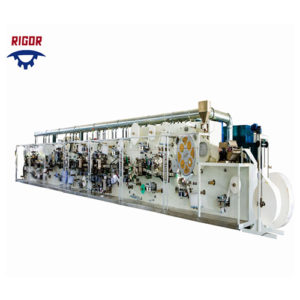The duration of operator training for using a sanitary napkin machine can vary depending on factors such as the complexity of the machine, the operator’s prior experience, the training program’s structure, and the level of automation involved. Generally, operator training can range from a few days to a few weeks.
Here are some factors that can influence the training duration:
Machine Complexity: The complexity of the machine and its control systems can impact the training duration. Machines with more advanced features or automation may require additional time for operators to understand and operate effectively.
Experience of Operators: If the operators have prior experience operating similar equipment or have a background in machine operation, they may require less training time. Familiarity with basic machine operation and understanding of manufacturing processes can expedite the training process.
Training Program Structure: The structure and effectiveness of the training program itself play a significant role. A well-structured training program with clear learning objectives, comprehensive training materials, hands-on practice, and ongoing support can streamline the training process.
Hands-on Practice: Hands-on practice is crucial for operators to gain proficiency in operating the sanitary napkin machine. Sufficient time should be allocated for operators to practice under supervision, allowing them to become familiar with the machine’s functions, troubleshooting, and maintenance procedures.
Troubleshooting and Maintenance: Training should cover troubleshooting common issues that may arise during machine operation and routine maintenance tasks. Operators should be trained to identify and resolve minor problems to minimize production downtime.
Safety and Quality Control: Training should include safety protocols and guidelines to ensure operators understand the potential hazards associated with the machine and follow proper safety practices. Additionally, operators should be trained on quality control measures to maintain the production of sanitary napkins that meet the required standards.
It’s essential for manufacturers of sanitary napkin machines to provide comprehensive training materials, conduct hands-on sessions, and offer ongoing support to operators. This helps ensure that operators are proficient in operating the machine safely, efficiently, and with adherence to quality standards.
What are some common troubleshooting issues that operators may encounter with a sanitary napkin machine?
Operators of sanitary napkin machines may encounter various troubleshooting issues during the operation of the machine. Here are some common issues that operators may come across and potential troubleshooting steps:
Material Feeding Issues: Operators may face problems with the feeding system that supplies the raw materials. This can lead to uneven material distribution or interruptions in the production process. Troubleshooting steps may involve checking the material feed mechanism, ensuring proper tension and alignment of the materials, and clearing any obstructions or jams in the feeding system.
Cutting and Shaping Problems: Issues related to cutting and shaping can result in inconsistent pad sizes, improper pad shapes, or jagged edges. Operators should check the cutting blades for sharpness and proper alignment. sanitary napkin machine Adjustment of cutting settings and clearing any debris or material buildup can help resolve cutting and shaping issues.
Adhesive Application: Problems with adhesive application can cause issues with pad integrity and bonding. Operators should verify the adhesive supply and distribution system, ensuring that the adhesive is applied evenly and in the correct quantity. Adjusting adhesive temperature and pressure settings can also help address adhesive-related problems.
Machine Jams: Jams can occur when the machine becomes clogged or obstructed during operation. Operators should follow proper safety procedures and clear the jammed area, removing any debris or tangled materials. Regular cleaning and maintenance of the machine can help minimize the occurrence of jams.
Machine Calibration and Settings: Calibration issues may lead to misalignment, improper tension, or inaccurate positioning of materials. Operators should review the machine’s calibration settings, ensuring they are properly adjusted to achieve the desired product specifications. Regular calibration checks and adjustments can help maintain consistent production output.
Sensor or Control System Malfunctions: Problems with sensors or control systems can disrupt the machine’s operation and affect the production process. Operators should check the sensor connections, clean any sensor lenses, and verify proper functioning of the control system. If necessary, contacting technical support or the machine manufacturer may be required for advanced troubleshooting.
Quality Control and Defects: Operators should regularly monitor the produced sanitary pads for quality defects such as improper bonding, uneven layers, or inadequate absorbency. Implementing quality control measures, including visual inspections, sample testing, and adherence to quality standards, can help identify and address any quality-related issues.
It’s important for operators to receive proper training on troubleshooting techniques specific to the sanitary napkin machine they are operating. Additionally, referring to the machine’s user manual, seeking guidance from technical support, or involving maintenance personnel can assist in resolving more complex issues.
